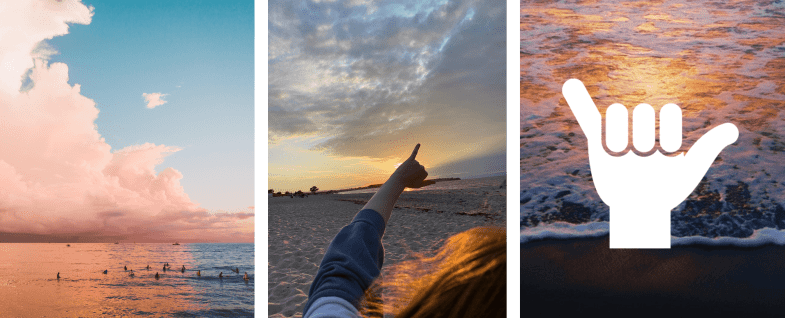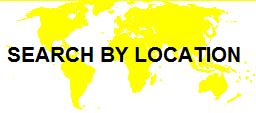
Surfflexicon A - Z
If you want to learn to surf, you should also know and understand a little bit about the expressions of a surfer, because in the long run you can't avoid such expressions as „beach break“, „tube“ or „wipe-out“.
A B C D E F G H I L M O P R S T W

Aerial = one of the most difficult surf tricks, where you leave the wave with the board by a high vertical jump and land back on the same wave
A-frame = an optimally shaped wave with a crest, on which take-offs are possible from this highest point to the right as well as to the left and the wave breaks evenly in both directions
Angling / Angle take-off = the oblique start and descent of a wave

Backside / Backhand = here the waves are surfed with the back to the wave wall
Barrel = a hollow space between the wall of the wave and the breaking part, the ultimate spot for surfers; also called tube
Beachbreak = waves breaking on a sandbank
Bottom turn = one of the most important manoeuvres, here the surfer turns his board back towards the wave wall after riding down the wave, in order to be able to continue surfing the wave
Breakers = so-called swell waves, which break when they reach the shallow coastal areas and hit sandbanks (beachbreak), reefs (reefbreak) or directly the foremost coastline (shorebreak) [here you will find more information]

Channel = no waves break in the channel, the water flows back into the sea and is used by surfers to paddle back into the line-up from the beach
Choppy = choppy and agitated water caused by strong winds or currents
Conditions= surfing conditions are understood to be environmental influences that provide optimal or suboptimal wave conditions depending on their characteristics. A distinction can be made between main and individual influencing factors. The main influences that specifically affect wave quality include the direction of the swell, the swell period and the swell height, and thus the resulting wave height, the tides, the wind and the bottom of the spot. Individual factors, e.g. how crowded the spot is or - especially for beginners - how large the standing area in the water is, can be added to the main factors and influence the conditions.
Current = are influenced by wind and tides, there are regional currents and currents that change in periods, but also global ocean currents that are constantly ongoing, there are various factors that can cause different currents: Temperature differences and different salinity levels together with solar radiation, wind, duration, cause, water temperature and location in the sea.
Surfers are mainly affected by currents caused by broken waves. The waves running towards the beach bring a lot of water with them towards the land, which flows back to the sea after the waves have broken, eventually creating a current. In addition to this current, it is also important to pay attention to the longitudinal coastal current, which runs parallel to the coast and pulls the surfer to the left or right in the line-up.
But beware: Currents can be dangerous, surf instructors give you clear instructions before you go into the water with the boards, where you should surf and where it is too dangerous
Cutback = a manoeuvre that follows the bottom turn. Here, the surfer rides the wave wall like an "S" from top to bottom. To do this, he first rides up the wave wall at an angle, makes a turn, surfs down the wave at an angle and makes another turn. Now the direction of view is the same as in the starting position. In a roundhouse cutback, the turns are executed so radically that the direction of travel changes by 180° each time

Drop = entering a wave directly after take-off
Drop-In = an absolute no-go among surfers, one surfer taking another's "right of way"
Duck-Dive = is a technique with which the surfer can cross the surf zone or individual broken waves. To do this, the surfer submerges the tip of the board and then pushes the rest of the board under water with his foot or knee. Finally, the surfer pulls himself under water by the board and resurfaces behind the wave. This technique is the most effective way to overcome white water waves

Floater = is one of the first tricks a surfer learns. The surfer heads for the lip of the wave and then surfs along it until the wave is surfed off towards the beach or into the green wave again

Glassy = an opposite and windless surf condition to choopy, the water here is absolutely calm, like glass. However, this does not mean that the sea is completely free of waves, the term does not refer to the entire sea but only to the surface of the water. Glassy surf conditions are every surfer's dream as the board lies much smoother in the waves
Green Room = the green room is the hollow space of the barrel/ tube, the surfer is completely surrounded by the wave
Green Wave = is an unbroken wave, the goal of every beginner to surf such a wave

Hang Loose = greeting among surfers, means something like "take it easy"; also called shaka
High tide = the water has reached its highest level, the waves break closer to the beach and due to the larger amounts of water, the waves run longer and can therefore be surfed for longer; low tide and tide are generated by the gravitational pull of the sun and moon on the earth
Frontside / Fronthand / Forehand = this involves surfing the waves with the face turned towards the wave wall

Impact Zone = the area where the lip of the wave crashes onto the water surface

Lefthander / Left = is a wave breaking from right to left, facing towards the beach, the wave is surfed off to the left; also simply called a left
Line-Up = area where surfers wait for waves
Lip = the upper part of the wave that appears when the wave starts to break. With steep waves, the lip can also break into a barrel
Low tide = the water has reached its lowest level, when the tide is out, the waves break further out than usual when there is high tide. Rocks and stones may appear, so be very careful at this time of the tide. If you want to go surfing alone, you should get information about the ground and possible dangers beforehand; high and low tides are created by the gravitational pull of the sun and moon on the earth

Mushy = an expression for a weak and powerless wave

Offshore = offshore wind, the wind comes from the coast; the waves break cleaner, are steeper and therefore also more difficult to ride
Off The Lip = a radical manoeuvre in which the surfer rides a turn against the lip of the wave
Onshore = onshore wind, the wind comes from the sea; the waves are of different heights, more irregular, but also easier to ride
Outside = the area further out behind the line-up. The surfers watch the wave sets here or to be able to surf the bigger set waves when the swell is very strong
Overhead = gives information about the wave height, which in this case extends above the head of the standing surfer

Peak = the exact point where the wave is highest and first starts to break
Pointbreak = waves breaking along the coast or a headland into a bay

Reefbreak = waves breaking on a reef
Re-Entry = one of the more radical manoeuvres, where the surfer makes a 180° turn against the breaking part of the wave
Righthander / Right = a wave breaking from the left to the right, facing the beach, which is surfed off to the right; also simply called right

Set = 3 - 7 waves coming at equal intervals, then there is a pause, followed by the next set
Shaka = this greeting, known worldwide among surfers, comes from Hawaii, the motherland of surfing. The thumb and little finger are extended and the other three fingers are bent like a fist; also called hang loose
Shorebreak = waves break directly on the beach when there are no sandbanks due to a steeply sloping shore
Sideshore = a wind direction running sideways to the coast
Surf Forecast = helps surfers to better estimate what conditions will prevail at a spot in the next few days, shows information on wave height, wave periods, wind strength and direction from which the wind is coming, and also when there are tides in general
Swell = the power of a wave

Take-Off = the base in surfing, refers to the process of getting from a lying to a standing position on the surfboard
Top Turn = unlike the bottom turn, surfing is against the top of the wave, the surfer rides up the wall of the wave and then turns their board back towards the bottom of the wave
Tow-In = the surfer being pulled into the wave by a third party, for example if the wave is too big or too fast for the surfer to paddle into it himself
Tube = a hollow space between the wall of the wave and the breaking part, the ultimate spot for surfers; also called barrel

White water waves = are already broken waves that can be recognised by white whitecaps
Wipe-Out = a heavy and spectacular fall from the surfboard on a wave, often followed by a wash in the white water




